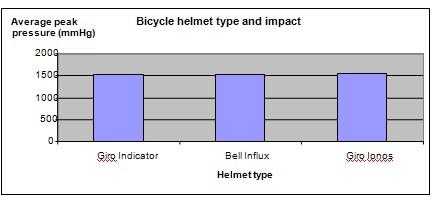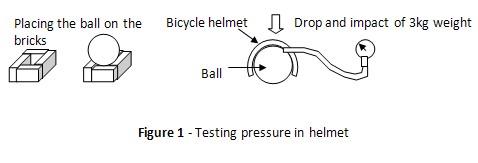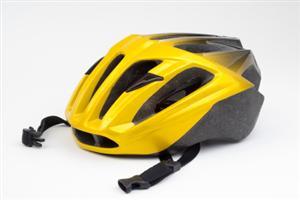| Complexity level: | 6 |
| Project cost ($): | 50 |
| Time required: | Preparation will take approximately two hours, and observation and recording of data will require another two hours |
| Material availability: | Easily found at a sports shop |
| Safety concerns: | Caution should be taken to prevent the falling weight from hitting anyone |
Hypothesis
A more expensive bicycle helmet will reduce the impact of on the head of its wearer.
Overview
Bicycle helmet
Bicycle helmets are part of the protective gear used by cyclist to protect their heads and skulls from injury during a crash or fall. An effective helmet has to be strong, light-weight and be sufficiently ventiled. As cycling is an intensive sport that raises the body temperature, ventilation is important for keeping the head cool.
The original bicycle helmets, which were meant for road cycling and road racing, have an elongated shape and are made of a thin plastic shell and expanded polystyrene (EPS) foam with adequate ventilation. Commuter bicycle helmets, which have a more rounded shape, were introduced more recently. They are also made using a thin plastic shell and EPS foam. In addition, accessories such as blinkers, mirrors and ear flaps can be found on commuter helmets.
During a head-on crash or collision, a force of impact with the colliding object (eg. a tree, vehicle or another rider) will normally be applied to the point of contact between that object and the head of the cyclist. This force may cause serious head injuries and may sometimes even lead to death. However, when a bicycle helmet is worn, the point of contact will be on the outer surface of the helmet. Upon impact, this force is distributed along the inner surface of the helmet. This distribution of force reduces the pressure on the cyclist’s head and will therefore minimize injuries.
Scientific Terms
Materials
Materials required for this science fair project:
- A 2 meter long string
- 1 Giro Indicator bike helmet
- 1 Bell Influx bike helmet
- 1 Giro Ionos bike helmet
- A 3 kg circular weight (~100 mm diameter) with a hole in the middle
- 1 basketball to fit inside the helmet
- 1 air pump
- 1 pressure gauge
- 4 bricks
- 1 chair
- 1 assistant
Procedure
1. The independent variable in this science fair project is the type of the bicycle helmet used. The dependent variable is the air pressure in the ball when the weight hits the helment, which is determined by measuring the maximum deflection in the air pressure gauge. The constants (control variables) are the height from which the weight was dropped, the mass and size of the weight, the size of the helmet, the size of the ball, and the initial pressure of the ball.
2. Three different brands of bicycle helmets will be used in this experiment. The Giro Indicator bike helmet is the cheapest, the Bell Influx bike helmet is middle-priced, while the Giro Ionos bike helmet is the most expensive.

3. Arrange the four bricks in a square and leave a small hole in the middle as shown in Figure 1. Pump the basketball to a pressure of 750 mmHg, and place it in the space between the bricks to prevent it from rolling away.
4. Secure the bicycle helmet over the ball as shown in Figure 1. Let the pressure gauge remain connected to the ball so that the increase in pressure can be observed.
5. Instruct the assistant to stand on the chair and hold the string vertically with the bottom end touching the center of the helmet, which will be the point of impact. Insert the tip of the string through the hole in the weight, and release the weight from the 2 meter height ,letting it travel down the string. Observe and record the maximum reading in the air pressure gauge. Repeat the test procedure for five times. Calculate the average reading and record it in the table given below.
6. Perform procedure 5 for all three brands of bicycle helmets. Record the average pressure reading in the table given below.


Results
The reading in the pressure gauge for all three brands of bicycle helmets was observed to be similar when the weight was released. This suggests that the impact of the collision was approximately the same for the basketball, regardless of the brand of bicycle helmet used.
| Measurement | Effect of different brands of bicycle helmets on the force of impact (mmHg) | ||
| Giro Indicator | Bell Influx | Giro Ionos | |
| Pressure on ball (mmHg) | 1532 | 1516 | 1545 |
Use the graph below to plot the experimental data recorded in the table below.

Conclusion
The experimental data and analyzed results do not support the hypothesis that a more expensive bicycle helmet will reduce the force of impact on a cyclist's head during a collision.
Bicycle helmets are available in many sizes for children, teenagers and adults, and have to be worn correctly to minimize the risk of injuries to the cyclist. Helmets have to be fixed on to the head using the straps provided, and adjusted accordingly to ensure a proper fit.
Also consider
Try to repeat the science fair project by increasing the height from which the weight was dropped, and try using heavier weights. Perhaps your results will be different? After all, a rider typically weights much more than 3kg. Also, repeat the experiment with different brands and models of helmet.
References
Bicycle helmet - http://en.wikipedia.org/wiki/Bicycle_helmet
Bicycle helmet types - http://www.bhsi.org/types.htm

